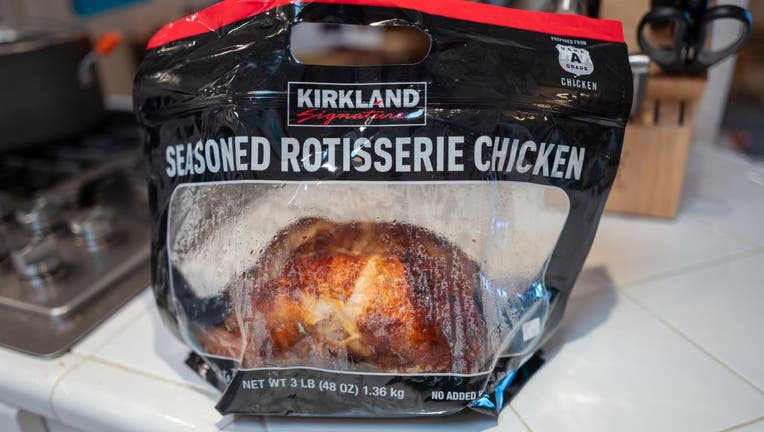Are the new Costco rotisserie chicken bags safe?

Kirkland brand rotisserie chicken from Costco, shown in plastic food service bag following a major change in packaging. (Photo by Smith Collection/Gado/Getty Images)
LOS ANGELES - In March 2024, Costco transitioned from hard plastic clamshell containers to flexible plastic bags for its rotisserie chickens in a move to reduce plastic use and carbon emissions.
While Costco says this change aims to cut plastic use by 75% and remove 1,000 trucks from the road annually, it has sparked widespread customer dissatisfaction.
This shift comes at a time when consumers are increasingly concerned about the presence of forever chemicals and microplastics in their food. The new bags have drawn particular concern because the hot chickens sit directly in the plastic, raising questions about potential chemical exposure.
Customer concerns about leaks
Many customers have taken to social media to voice their frustrations over the new bags, primarily citing issues with leaks.
Reports from Reddit and TikTok highlight problems with greasy bags and chicken juice seeping out, creating messes in shopping carts, car trunks, and countertops.
Expert opinions on plastic safety
Beyond the inconvenience of leaks, there are concerns about the safety of these new plastic bags in terms of chemical exposure.
According to Consumer Reports, while the bags are reportedly designed to be FDA-approved for hot food storage, minimizing the duration hot food is kept in any plastic packaging is recommended to avoid potential leaching of plastic additives or breakdown of the plastic polymer.
Dr. Shannon Fitzgerald is a pharmacist, toxicologist and a medical contributor for Drugwatch., elaborated on the risks associated with hot food in plastic bags.
"By grabbing plastic too, you're getting a lot of those phthalates and a lot of the chemical composition that's in that plastic. You're getting it to leach into the food that you're consuming," she explains.
Fitzgerald highlights that even a small amount of plastic consumption can be concerning, given that the average American consumes about five grams of plastic weekly, equivalent to a credit card.
Costco has not yet responded to comment on the safety of their new plastic bags.
Tunde Akinleye, Consumer Reports' test program leader for food safety, addressed whether Costco’s new softer plastic, which is flexible and makes contact with hot, cooked chicken, poses more of an issue regarding plastic chemicals that could leach into food.
"The answer would depend on the type of plastic bag," Akinleye said. "The FDA-approved plastic bags for storing hot food include polypropylene or PP (plastic #5) and polyethylene terephthalate or PET (plastic #1). Both are considered safe for storing hot food items. Others, such as high-density polyethylene or HDPE (plastic #2), or low-density polyethylene or LDPE (plastic #4), are not as effective for hot food storage as PP or PET."

What are microplastics?
Microplastics are pieces of plastic that measure less than 5 millimeters and these tiny particles are finding their way into our drinking water, food, and even our blood.
That said, Akinleye adds that it’s always advisable to keep hot food in contact with any plastic material to as short a period as possible.
"That’s because both conventional heating and high-temperature storage of food in most types of plastic can lead to leaching of very small amounts of plastic additives or breakdown of the plastic polymer itself over time," he says.
Food safety advice
Experts suggest that despite cooked chicken being less risky than raw chicken in terms of pathogens, any leaked juices can still become a breeding ground for bacteria if left unchecked.
Proper cleaning of any surfaces or reusable bags that come into contact with these juices is crucial to maintain food safety.
"The heat I think, is one of the big things. So it's starting to break down. And that's where we get the microplastics from some of the plastics that we had before," Fitzgerald explains.
What are microplastics and forever chemicals?
Known as "forever chemicals" for their persistence in the environment, per- and polyfluoroalkyl substances (PFAS) have been used for decades to prevent grease, water, and other liquids from soaking through wrappers, boxes, and bags. These microplastics and forever chemicals are not just found in food packaging but are unfortunately pervasive in nearly every aspect of our lives.
READ MORE: Study: Consumer products containing phthalates increase risk of uterine tumor growth
Microplastics are tiny pieces of plastic debris that measure less than 5 millimeters, and nanoplastics measure less than 1 micrometer. Due to their minuscule size, these particles are not easily detectable to the naked eye. They result from the breakdown of larger plastic items and are found in a variety of consumer products including shower curtains, car upholstery, lunchboxes, and shoes. A study published last year highlighted that these chemicals can increase the growth of uterine tumors known as fibroids.
In 2023, numerous companies involved in food packaging faced significant pressure after the toxic industrial compound PFAS was detected in fast-food wrappers, boxes, and plates. Environmental and health groups have been advocating for the removal of PFAS chemicals from packaging due to their potential health risks. These groups have pushed fast food companies, supermarket chains, and other retail outlets to eliminate PFAS from their products.
The pervasive nature of these chemicals underscores the need for greater awareness and regulatory measures to mitigate their impact on health and the environment.

